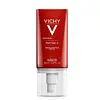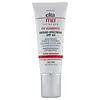What's inside
What's inside
 Key Ingredients
Key Ingredients

 Benefits
Benefits

 Concerns
Concerns

 Ingredients Side-by-side
Ingredients Side-by-side

Butyl Methoxydibenzoylmethane 3%
UV AbsorberHomosalate 5%
Skin ConditioningEthylhexyl Salicylate 5%
UV AbsorberOctocrylene 7%
UV AbsorberWater
Skin ConditioningGlycerin
HumectantDimethicone
EmollientSilica
AbrasivePEG-100 Stearate
Glyceryl Stearate
EmollientGlycolic Acid
BufferingStearic Acid
CleansingDicaprylyl Carbonate
EmollientSteareth-100
Gel FormingDimethicone/Vinyl Dimethicone Crosspolymer
Skin ConditioningSodium Hydroxide
BufferingSodium Hyaluronate
HumectantMyristic Acid
CleansingCyclodextrin
AbsorbentPalmitic Acid
EmollientPhenoxyethanol
PreservativePhenylethyl Resorcinol
AntioxidantGuanosine
Skin ConditioningAmmonium Polyacryloyldimethyl Taurate
Emulsion StabilisingAscorbyl Glucoside
AntioxidantTocopherol
AntioxidantCaprylyl Glycol
EmollientTrisodium Ethylenediamine Disuccinate
Xanthan Gum
EmulsifyingPentaerythrityl Tetra-Di-T-Butyl Hydroxyhydrocinnamate
AntioxidantPisum Sativum Extract
Skin ConditioningParfum
MaskingButyl Methoxydibenzoylmethane 3%, Homosalate 5%, Ethylhexyl Salicylate 5%, Octocrylene 7%, Water, Glycerin, Dimethicone, Silica, PEG-100 Stearate, Glyceryl Stearate, Glycolic Acid, Stearic Acid, Dicaprylyl Carbonate, Steareth-100, Dimethicone/Vinyl Dimethicone Crosspolymer, Sodium Hydroxide, Sodium Hyaluronate, Myristic Acid, Cyclodextrin, Palmitic Acid, Phenoxyethanol, Phenylethyl Resorcinol, Guanosine, Ammonium Polyacryloyldimethyl Taurate, Ascorbyl Glucoside, Tocopherol, Caprylyl Glycol, Trisodium Ethylenediamine Disuccinate, Xanthan Gum, Pentaerythrityl Tetra-Di-T-Butyl Hydroxyhydrocinnamate, Pisum Sativum Extract, Parfum
Zinc Oxide
Cosmetic ColorantTitanium Dioxide
Cosmetic ColorantAscorbyl Palmitate
AntioxidantSodium Hyaluronate
HumectantWater
Skin ConditioningCyclopentasiloxane
EmollientDimethicone
EmollientOctyldodecyl Neopentanoate
EmollientLauryl PEG-9 Polydimethylsiloxyethyl Dimethicone
Skin ConditioningDimethicone/PEG-10/15 Crosspolymer
Tocopherol
AntioxidantSodium Chloride
MaskingTriethoxycaprylylsilane
Alumina
AbrasiveHydrogen Dimethicone
Potassium Sorbate
PreservativePhenoxyethanol
PreservativeCitric Acid
BufferingIron Oxides
Zinc Oxide, Titanium Dioxide, Ascorbyl Palmitate, Sodium Hyaluronate, Water, Cyclopentasiloxane, Dimethicone, Octyldodecyl Neopentanoate, Lauryl PEG-9 Polydimethylsiloxyethyl Dimethicone, Dimethicone/PEG-10/15 Crosspolymer, Tocopherol, Sodium Chloride, Triethoxycaprylylsilane, Alumina, Hydrogen Dimethicone, Potassium Sorbate, Phenoxyethanol, Citric Acid, Iron Oxides
 Reviews
Reviews

Ingredients Explained
These ingredients are found in both products.
Ingredients higher up in an ingredient list are typically present in a larger amount.
Dimethicone is a type of synthetic silicone created from natural materials such as quartz.
What it does:
Dimethicone comes in different viscosities:
Depending on the viscosity, dimethicone has different properties.
Ingredients lists don't always show which type is used, so we recommend reaching out to the brand if you have questions about the viscosity.
This ingredient is unlikely to cause irritation because it does not get absorbed into skin. However, people with silicone allergies should be careful about using this ingredient.
Note: Dimethicone may contribute to pilling. This is because it is not oil or water soluble, so pilling may occur when layered with products. When mixed with heavy oils in a formula, the outcome is also quite greasy.
Learn more about DimethiconePhenoxyethanol is a preservative that has germicide, antimicrobial, and aromatic properties. Studies show that phenoxyethanol can prevent microbial growth. By itself, it has a scent that is similar to that of a rose.
It's often used in formulations along with Caprylyl Glycol to preserve the shelf life of products.
Sodium Hyaluronate is hyaluronic acid's salt form. It is commonly derived from the sodium salt of hyaluronic acid.
Like hyaluronic acid, it is great at holding water and acts as a humectant. This makes it a great skin hydrating ingredient.
Sodium Hyaluronate is naturally occurring in our bodies and is mostly found in eye fluid and joints.
These are some other common types of Hyaluronic Acid:
Learn more about Sodium HyaluronateTocopherol (also known as Vitamin E) is a common antioxidant used to help protect the skin from free-radicals and strengthen the skin barrier. It's also fat soluble - this means our skin is great at absorbing it.
Vitamin E also helps keep your natural skin lipids healthy. Your lipid skin barrier naturally consists of lipids, ceramides, and fatty acids. Vitamin E offers extra protection for your skin’s lipid barrier, keeping your skin healthy and nourished.
Another benefit is a bit of UV protection. Vitamin E helps reduce the damage caused by UVB rays. (It should not replace your sunscreen). Combining it with Vitamin C can decrease sunburned cells and hyperpigmentation after UV exposure.
You might have noticed Vitamin E + C often paired together. This is because it is great at stabilizing Vitamin C. Using the two together helps increase the effectiveness of both ingredients.
There are often claims that Vitamin E can reduce/prevent scarring, but these claims haven't been confirmed by scientific research.
Learn more about TocopherolWater. It's the most common cosmetic ingredient of all. You'll usually see it at the top of ingredient lists, meaning that it makes up the largest part of the product.
So why is it so popular? Water most often acts as a solvent - this means that it helps dissolve other ingredients into the formulation.
You'll also recognize water as that liquid we all need to stay alive. If you see this, drink a glass of water. Stay hydrated!
Learn more about Water